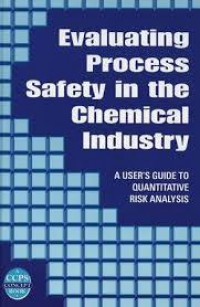
Electronic Resource
Evaluating Process Safety in the Chemical Industry
Quantitative risk analysis (QRA) is a powerful analysis approach used to help manage risk and improve safety in many industries. When properly performed with appropriate respect for its theoretical and practical limitations, QRA provides a rational basis for evaluating process safety and comparing improvement alternatives. However, QRA is not a panacea that can solve all problems, make decisions for a manager, or substitute for existing safety assurance and loss prevention activities. Even when QRA is preferred, qualitative results, which always form the foundation for QRA, should be used to verify and support any conclusions drawn from QRA.
The American Chemistry Council, the Center for Chemical Process Safety, and their member companies recognize the need to provide decision makers with a guide to QRA. Chemical process industry (CPI) professionals at every level (plant managers, project managers, engineers, supervisors, etc.) need criteria for determining when risk analysis will provide information that will aid their decision making. Executives need help in understanding and evaluating QRA results that are often inscrutable to nonexperts. And all need advice concerning how detailed an analysis must be if it is to provide adequate information for a specific decision. By illustrating the judicious use of QRA, this guide will help managers use their limited resources more efficiently. This guide summarizes some of the wisdom accumulated by CPI risk analysis practitioners and safety professionals; decision makers considering the use of QRA can benefit from this collected experience. Even though this guideline does not address every issue and circumstance concerning the use of QRA, we believe that you will be able to blend your experience with the strategies provided in this guide to make more informed decisions about using QRA.
Ketersediaan
Tidak ada salinan data
Informasi Detail
- Judul Seri
-
-
- No. Panggil
-
-
- Penerbit
- New York : Springer Science Business Media., 2000
- Deskripsi Fisik
-
ebook
- Bahasa
-
English
- ISBN/ISSN
-
0-8169-0746-3
- Klasifikasi
-
NONE
- Tipe Isi
-
-
- Tipe Media
-
-
- Tipe Pembawa
-
-
- Edisi
-
-
- Subjek
-
-
- Info Detail Spesifik
-
-
- Pernyataan Tanggungjawab
-
-
Versi lain/terkait
Tidak tersedia versi lain
Lampiran Berkas
Komentar
Anda harus masuk sebelum memberikan komentar
 Karya Umum
Karya Umum  Filsafat
Filsafat  Agama
Agama  Ilmu-ilmu Sosial
Ilmu-ilmu Sosial  Bahasa
Bahasa  Ilmu-ilmu Murni
Ilmu-ilmu Murni  Ilmu-ilmu Terapan
Ilmu-ilmu Terapan  Kesenian, Hiburan, dan Olahraga
Kesenian, Hiburan, dan Olahraga  Kesusastraan
Kesusastraan  Geografi dan Sejarah
Geografi dan Sejarah